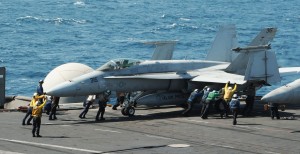
A V-22 Osprey tilting its rotors
With 19 Marines killed in two aircraft crashes since July 10th, Marine Corps Commandant Robert Neller has ordered all aviation units to stand down for safety reviews. This summer’s crashes come after months of rising accident rates, with a total of 22 deaths and 18 “Class A Mishaps” – incidents involving loss of life or $2 million in damages – since last spring, plus numerous lesser accidents.

General Robert Neller
Neller didn’t say what he thought was causing the problem, which has afflicted multiple types of aircraft all around the world. The deadliest crash, which killed 16 Marines on July 10th, occurred in Mississippi and involved one of the military’s oldest aircraft, the propeller-driven KC-130 tanker/transport. But the most recent crash, which killed three Marines on August 5th, occurred in Australia and involved the much newer MV-22 Osprey, a helicopter-like tiltrotor. A previous stand-down last August was triggered by three crashes of aging F-18 Hornet fighter jets.
House Armed Services chairman Mac Thornberry immediately blamed the deaths on a “readiness crisis.” Thornberry and his allies have pushed to lift the spending caps created by the Budget Control Act of 2011, which they believe has dangerously shortchanged the military in multiple, interrelated areas:
- Insufficient funding for maintenance has left aircraft prone to breakdowns.
- Insufficient funding for training has left pilots out of practice.
- Insufficient funding for new equipment has left pilots flying aging, less safe aircraft like the KC-130 and the F-18C.
With all three factors at work at once, the chance of fatal accidents increased exponentially.

KC-130 landing.
Silver Linings & Canaries in Coal Mines
While the stand-down is grim news, it’s crucial to note that Gen. Neller didn’t ground the whole air fleet at once. Instead, each squadron must schedule a 24 hour “operational reset” sometime in the next two weeks, without affecting “operational commitments.” This implies that all the aircraft of a particular type at a particular location – say, all the fighters at a given base – can’t stand down at the same time, but must take turns so there are always aircraft available for missions.

F/A-18C Hornet aboard USS George H.W. Bush
The stand-down itself will involve “reviewing(ing) selected incidents (and) historical examples… to focus on the fundamentals of safe flight,” essentially an intensive study session.
Neller’s statement emphasizes such “pauses in operations are not uncommon.” That said, however, what’s happening in Marine aviation in recent years is definitely out of the ordinary.
The crucial question is whether the Marine Corps’ problems are unique or are a canary in the coal mine for all four services. While the US military has dealt with aging equipment, maintenance shortfalls, and training cutbacks, the Marines fly a particularly old air fleet. In particular, the Marines decided in the 1990s not to buy the newer F/A-18E Super Hornet like the Navy, forcing them to keep old-model Hornets and the notoriously troublesome AV-8B Harriers in service until the much-delayed F-35B Joint Strike Fighters come along. But like all new planes, the F-35Bs have suffered teething troubles of their own, including a software glitch that recently grounded the fleet.
Are the Marines in deeper trouble than the Army, Navy, and Air Force? Or do chronic oxygen supply problems in Navy and Air Force aircraft indicate a much wider problem, Thornberry’s military-wide readiness crisis? We don’t know – yet.

What Gen. Neller and Rep. Thornberry Said
Here’s the complete text of Gen. Neller’s statement:
General Robert B. Neller, Commandant of the U.S. Marine Corps, directed U.S. Marine Corps aviation units to conduct an operational reset for a 24 hour-period where no flight operations will take place but no operational commitments will be impacted.
This operational reset will occur within the next two weeks and will be taken at the discretion of commanders, based on their unit’s operational commitments, to focus on the fundamentals of safe flight operations, standardization, and combat readiness. The intent is for flying squadrons to review selected incidents which occurred enterprise-wide and study historical examples of completed investigations in order to bring awareness and best practices to the fleet.
Pauses in operations are not uncommon and are viewed as a responsible step to refresh and review best practices and procedures so our units remain capable, safe, and ready.

Rep. Mac Thornberry
And here’s the complete text of Chairman Thornberry’s:
“The Marine Corps decision to temporarily ground all aircraft is further, indisputable evidence that America’s military is in a readiness crisis, and that the crisis is costing lives. Washington has asked our military to do too much with too little for too long. As threats continue to grow, Congress must act as soon as possible to provide our military with all of the resources they need to repair what can be fixed and replace what cannot be repaired. It would be immoral to continue to use military funding as political leverage in the face of such striking evidence that our military is in a crisis that is partly of our own making.”
Northrop sees F-16 IVEWS, IBCS as ‘multibillion dollar’ international sales drivers
In addition, CEO Kathy Warden says the company sees a chance to sell up to five Triton UAVs to the NATO alliance.


























